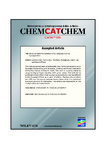Structure‐reactivity relations in Ru catalysed furfural hydrogenation
| dc.contributor.author | Durndell, Lee | |
| dc.contributor.author | Zou, G | |
| dc.contributor.author | Shangguan, W | |
| dc.contributor.author | Lee, A | |
| dc.contributor.author | Wilson, K | |
| dc.date.accessioned | 2019-04-25T11:25:37Z | |
| dc.date.available | 2019-04-25T11:25:37Z | |
| dc.date.issued | 2019-04-23 | |
| dc.identifier.issn | 1867-3880 | |
| dc.identifier.issn | 1867-3899 | |
| dc.identifier.other | cctc.201900481 | |
| dc.identifier.uri | http://hdl.handle.net/10026.1/13743 | |
| dc.description.abstract |
<jats:title>Abstract</jats:title><jats:p>Furfural is an abundant and low‐cost bio‐derived platform chemical, obtained by xylose dehydration, and an important precursor to furfuryl alcohol and furan resins. The liquid phase selective hydrogenation of furfural to furfuryl alcohol was systematically investigated over silica supported Ru nanoparticles to elucidate structure‐reactivity relations and obtain mechanistic insight. Furfural hydrogenation to furfuryl alcohol is weakly structure sensitive for Ru nanoparticles spanning 2 to 25 nm, and the dominant reaction pathway reaching 95 % selectivity under our conditions (<25 bar H<jats:sub>2</jats:sub> and 100–165 °C). In contrast, furfural decarbonylation to furan exhibits a strong structure sensitivity, being favoured over sub‐10 nm particles. Increasing <jats:italic>p</jats:italic>H<jats:sub>2</jats:sub> from 10 to 25 bar resulted in a modest increase in C=O hydrogenation, while higher temperatures promoted ring‐opening of furfuryl alcohol.</jats:p> | |
| dc.format.extent | 3927-3932 | |
| dc.language | en | |
| dc.language.iso | en | |
| dc.publisher | Wiley | |
| dc.subject | Ruthenium | |
| dc.subject | Furfural | |
| dc.subject | Hydrogenation | |
| dc.subject | Heterogeneous catalysis | |
| dc.subject | Mesoporous silica | |
| dc.title | Structure‐reactivity relations in Ru catalysed furfural hydrogenation | |
| dc.type | journal-article | |
| dc.type | Journal Article | |
| plymouth.author-url | https://www.webofscience.com/api/gateway?GWVersion=2&SrcApp=PARTNER_APP&SrcAuth=LinksAMR&KeyUT=WOS:000498036500040&DestLinkType=FullRecord&DestApp=ALL_WOS&UsrCustomerID=11bb513d99f797142bcfeffcc58ea008 | |
| plymouth.issue | 16 | |
| plymouth.volume | 11 | |
| plymouth.publication-status | Published | |
| plymouth.journal | ChemCatChem | |
| dc.identifier.doi | 10.1002/cctc.201900481 | |
| plymouth.organisational-group | /Plymouth | |
| plymouth.organisational-group | /Plymouth/Faculty of Science and Engineering | |
| plymouth.organisational-group | /Plymouth/Faculty of Science and Engineering/School of Geography, Earth and Environmental Sciences | |
| plymouth.organisational-group | /Plymouth/REF 2021 Researchers by UoA | |
| plymouth.organisational-group | /Plymouth/REF 2021 Researchers by UoA/UoA12 Engineering | |
| plymouth.organisational-group | /Plymouth/Users by role | |
| plymouth.organisational-group | /Plymouth/Users by role/Academics | |
| dcterms.dateAccepted | 2019-04-23 | |
| dc.rights.embargodate | 2020-4-22 | |
| dc.identifier.eissn | 1867-3899 | |
| dc.rights.embargoperiod | Not known | |
| rioxxterms.versionofrecord | 10.1002/cctc.201900481 | |
| rioxxterms.licenseref.uri | http://www.rioxx.net/licenses/all-rights-reserved | |
| rioxxterms.licenseref.startdate | 2019-04-23 | |
| rioxxterms.type | Journal Article/Review |


